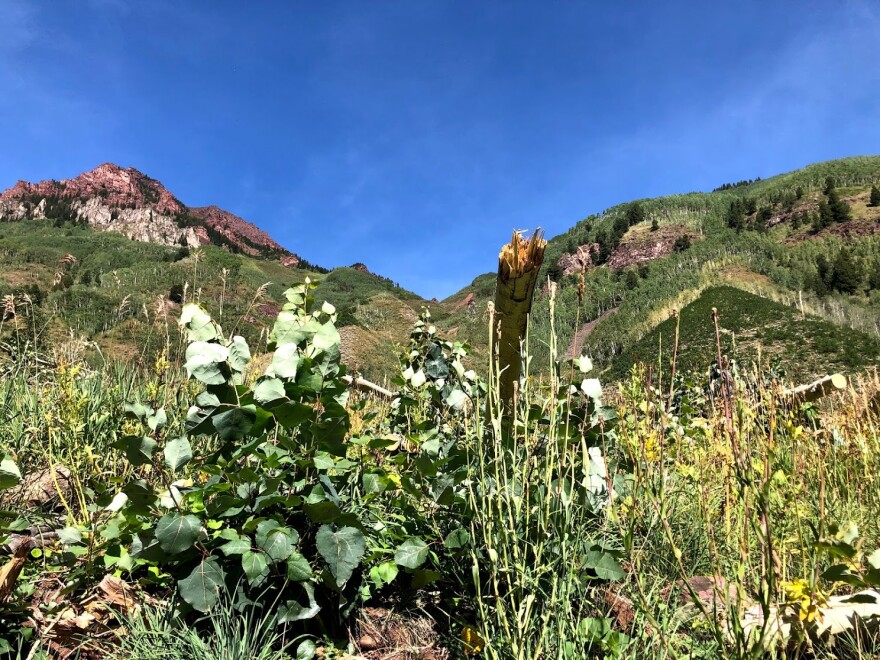Just as new research shows that aspen forests are a fountain of biodiversity, Aspen’s namesake trees in the Roaring Fork River watershed are battling warming temperatures, drier conditions, climate disruption, and unchecked herds of deer and elk. Although local aspen forests are currently still healthy, they face serious challenges.
There are a few small aspen groves in Pitkin County’s Sky Mountain Park, tucked in valleys where there’s more moisture than what the surrounding oak brush needs — and Elise Osenga, a researcher at the Aspen Global Change Institute, keeps a close eye on these groves. Osenga leads a program that monitors soil moisture as part of efforts to better understand climate conditions in the Roaring Fork River watershed. Two of the monitoring stations — one at Sky Mountain and the other at North Star Nature Preserve — are in aspen groves.
“We are interested in seeing,” Osenga said, “if soils are consistently drier over time, are the aspen able to survive?”
There is not yet a long history of local soil conditions, but Osenga recently completed an assessment of the health of aspens near the two research stations.
“The good news of what we found is we didn't actually find many dead trees at this point,” she said. But Osenga noted that aspens can die off in sustained droughts or even after just one or two really dry years. Additionally, as temperatures rise with a changing climate, the rain that does fall evaporates more quickly, further drying out soils.
Other local experts have found that there are local aspen groves that are struggling.
“It’s really those south-facing, dry slopes where the aspen decline is pretty evident,” said Adam McCurdy, forest programs director at the Aspen Center for Environmental Studies.
He pointed to groves near the radio tower on the Sunnyside Trail and up Castle Creek near the Toklat Gallery. Throughout the West and particularly in southwest Colorado, aspen trees on south- and southwest-facing slopes at low elevations are declining.
But overall, the local forests are faring pretty well, McCurdy said. In fact, aspens thrive on disruptions.
Dry conditions can mean increased risk of wildfire and bark-beetle infestations in evergreens, which thin forests and create openings for aspens to reproduce.
In the mountains around Aspen, avalanches have cleared paths for aspen trees to peek through evergreen forests, creating landscape-level diversity that benefits the local ecosystem.
“This really serves to break up the large stretches of what would otherwise be just spruce-fir forests and makes our forests more resilient to beetles and fire and all sorts of other disturbance,” McCurdy said.

Young aspens are already taking root in the paths cleared by last spring’s historic avalanche cycle — and creating space for all kinds of forest life.
Quaking aspen leaves let sunlight through the canopy, and the deep, rich soils under aspen communities hold more moisture than those in conifer forests. Such a combination of moisture and sunlight is the magic ticket for diverse life.
“Under aspen communities, there might be up to a hundred different plant species, and then some people have made tabulations of 50, 60 or more animals using aspen on a daily basis,” said Paul Rogers, director of Western Aspen Alliance, which coordinates research and management of aspen ecosystems across western North America.
Rogers co-authored a recent review of aspen research that contends that conservation of aspen ecosystems can benefit global biodiversity. Rogers and more than a dozen fellow researchers argue for a “mega-conservation” strategy: By sustaining the keystone aspen forests, a wide range of species would also be protected.
But, in addition to drier soils, aspen forests across the world are under stress from human activities such as mining, logging and urban development — as well as from some of the very wildlife they help support. Young trees are particularly nutritious and attractive to elk and deer, and herds sometimes stay in one spot for days, eating all the new shoots.
This results in an aging forest, and when the old trees start to die off, “you have a real problem,” Rogers said. “And so, if you combine that with drought, which is happening throughout Colorado, throughout the Western states, that is the biggest threat to aspen ecosystems.”
Rogers noted that Colorado Parks and Wildlife managers have increased the targeted size of elk herds over decades. The population goal for the Avalanche Creek elk herd, for example, increased from 3,300 in 1988 to a range of 3,600-5,400 in 2013.
“We’ve taken away predators, for the most part, that are going to keep those populations in check, but we’ve also managed those big herbivore populations for economics, quite frankly,” Rogers said. “Every state sells hunting licenses, and so to keep those revenues up, they keep those populations high. And those high populations have an impact on ecosystems.”
Editor’s note: Aspen Public Radio collaborates with Aspen Journalism on coverage of environmental issues.



